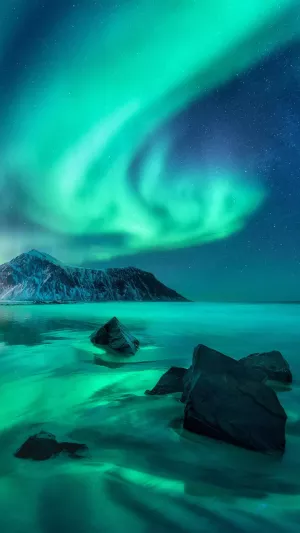Auroras, often referred to as the Northern Lights in the Northern Hemisphere and the Southern Lights in the Southern Hemisphere, is one of the most mesmerizing phenomena in nature.
With a history of observation spanning over two millennia in China alone, these luminous displays have captured the human imagination like no other natural spectacle.
Auroras manifest in a kaleidoscope of colors and shapes, defying any attempt by mere words or illustrations to fully capture their dazzling and ever-changing essence. The phenomenon occurs in the upper atmosphere at high latitudes of the Earth, primarily as a result of the interaction between the solar wind and the Earth's magnetic field.
These awe-inspiring displays are essentially massive electrical discharges encircling the Earth. Charged particles from the sun, propelled by the solar wind, journey towards the Earth. Upon reaching the Earth's vicinity, the planet's magnetic field redirects some of these particles along magnetic field lines towards the north and south poles.
As these charged particles travel through the upper atmosphere near the poles, they collide with atoms and molecules, exciting them and causing them to emit light. This luminous dance in the sky, known as the aurora borealis in the northern hemisphere and aurora australis in the southern hemisphere, ensues as a result.
The intricate dance of the auroras is intricately linked to the complex interplay between the Earth's upper atmosphere, its magnetic field, and the high-speed stream of charged particles from the sun, known as the solar wind. This celestial ballet unfolds under the precise conditions provided by these three elements.
Notably, auroras are not unique to Earth; other planets in the solar system with atmospheres, magnetic fields, and exposure to the solar wind also boast their own auroras. Jupiter and Mercury, among others, have been observed with auroras dancing around their poles, echoing the celestial spectacle witnessed on Earth.
While the aurora itself is a visual feast for the eyes, it is not the only sensory delight associated with this phenomenon. Accompanying the aurora borealis is a mysterious sound that has long intrigued and sometimes unsettled observers. This enigmatic crackling sound has been the subject of legends, inspiring both fear and wonder among those who have experienced it firsthand.
Recent research conducted by scientists at Aalto University in Finland has shed light on the source of these mysterious auroral sounds. The study revealed that the sound emanates from approximately 70 meters above the ground, a striking contrast to the aurora itself, which occurs some 120 kilometers above the Earth's surface.
To unravel the mystery behind the auroral sounds, researchers deployed three separate microphones to record the phenomenon's auditory component at observation points. By comparing the recorded sounds with concurrent measurements of geomagnetic interference conducted by the Finnish Meteorological Institute, scientists were able to pinpoint the source of the auroral sounds.
Despite this significant breakthrough, the exact mechanism behind the mysterious auroral sounds remains elusive. Notably, these sounds do not consistently accompany the visual spectacle of the aurora, often manifesting as an indistinct crackle that fades quickly. Various descriptions of the auroral sounds, ranging from distant crackling to ethereal whispers, hint at the possibility of multiple underlying mechanisms.
While science has made strides in unraveling the mysteries of auroras, much remains to be discovered about these captivating phenomena and the enigmatic sounds that accompany them.
The aurora
Video: NASA Space Place





